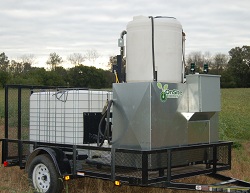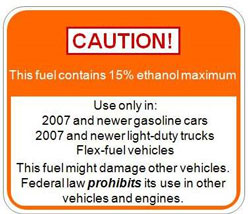Groups that represent the biodiesel and ethanol industries in this country believe when Congress comes back to Washington after the election … for what is known as the lame duck session … members could renew the pending federal $1-a-gallon biodiesel tax credit and the Volumetric Ethanol Excise Tax Credit (VEETC).
 Michael Frohlich, Director of Federal Communications for the National Biodiesel Board’s Washington, DC office tells Domestic Fuel that while it’s not a sure thing, there seems to be many of the pieces in place.
Michael Frohlich, Director of Federal Communications for the National Biodiesel Board’s Washington, DC office tells Domestic Fuel that while it’s not a sure thing, there seems to be many of the pieces in place.
“That being said, though, it’s very difficult to handicap or put what the odds might be because the length of the lame duck session and how they approach it could vary differently depending on the outcome of the upcoming mid-term elections.”
Frohlich adds that if the Republicans take control of the U.S. House or Senate, there’s two schools of thought that could both help the biodiesel credit’s chances: 1. members will try to cram something they’ve wanted through before the change, or 2. everyone will be a lot more amicable. He says another issue that could cause problems is finding an offset to meet Congress’ pay-go rules to pay for the credit.
 Meanwhile, in a piece for Ethanol Producer Magazine, Renewable Fuels Association President Bob Dinneen says since the VEETC has been vetted and enjoys bipartisan support, it could be ripe for a lame duck session victory:
Meanwhile, in a piece for Ethanol Producer Magazine, Renewable Fuels Association President Bob Dinneen says since the VEETC has been vetted and enjoys bipartisan support, it could be ripe for a lame duck session victory:
With a lame duck Congress in chaos resulting from the retirements and new members-elect, it will not have an appetite for new legislation that requires committee hearings and markups. Rather, it will be looking to legislation and policies that are already vetted and, for lack of a better analogy, they can simply cut and paste.
Frohlich adds that the lack of support from the Obama Administration, despite paying lip service to supporting green fuels, has been frustrating.
“It seems like it’s great for a press event or a soundbite, [but] they can’t see the forest for the trees.” He says 24,000 jobs could be either saved or created with the renewal of the biodiesel tax credit … at a time when this country desperately needs to put people back to work.
“It’s kind of one of those things where you’re left scratching your head wondering why something so fundamental and rudimentary Congress seems to ignore.”
Listen to my conversation with Michael here: Michael Frohlich, NBB
 The webcast will be coming from CME’s third annual Global Financial Leadership Conference in Naples, Florida and the panel will focus on commodity markets and the fundamental factors driving supply and demand for global food and energy. Participants will include Tim Gallagher, Executive Vice President–Grains and Biofuels, Bunge North America; Ian Goldin, Former Vice President, World Bank and Director, Oxford University’s Oxford Martin School; John Hofmeister, Former President, Shell Oil Company and Founder and Chief Executive Officer, Citizens for Affordable Energy. The webcast of the panel will be from 1:20 to 2:00 pm Eastern time.
The webcast will be coming from CME’s third annual Global Financial Leadership Conference in Naples, Florida and the panel will focus on commodity markets and the fundamental factors driving supply and demand for global food and energy. Participants will include Tim Gallagher, Executive Vice President–Grains and Biofuels, Bunge North America; Ian Goldin, Former Vice President, World Bank and Director, Oxford University’s Oxford Martin School; John Hofmeister, Former President, Shell Oil Company and Founder and Chief Executive Officer, Citizens for Affordable Energy. The webcast of the panel will be from 1:20 to 2:00 pm Eastern time.





 The Environmental Protection Agency has
The Environmental Protection Agency has  Meanwhile, Dinneen says the industry is working together on the technical issues to make this limited introduction of the ethanol blend as smooth as possible. “First, working with
Meanwhile, Dinneen says the industry is working together on the technical issues to make this limited introduction of the ethanol blend as smooth as possible. “First, working with  Heavy rains, nearly 60 percent higher than average for the month, hampered cane crushing for second consecutive two-week period, but reportedly favored ethanol production in the South-Central Brazil region. UNICA Technical Director Antonio de Padua Rodrigues says they are experiencing “another exceptional year” in terms of weather conditions. “From April to early September, the amount of rain was well below the historic average, reducing the availability of cane. Already in September, especially at the end of the month, rainfall returned with greater intensity than expected, hampering the harvest and, more importantly, reducing the quality of cane that will be crushed in October,” he said, adding that these factors should impact the overall production of sugar and ethanol at the end of the harvest.
Heavy rains, nearly 60 percent higher than average for the month, hampered cane crushing for second consecutive two-week period, but reportedly favored ethanol production in the South-Central Brazil region. UNICA Technical Director Antonio de Padua Rodrigues says they are experiencing “another exceptional year” in terms of weather conditions. “From April to early September, the amount of rain was well below the historic average, reducing the availability of cane. Already in September, especially at the end of the month, rainfall returned with greater intensity than expected, hampering the harvest and, more importantly, reducing the quality of cane that will be crushed in October,” he said, adding that these factors should impact the overall production of sugar and ethanol at the end of the harvest. According to a
According to a  The commercial potential of cellulosic ethanol in Brazil is substantial due to the great amount of sugarcane bagasse, a fibrous residue of sugarcane production, available in the country. Brazil is the world’s largest sugarcane producer with an extraction capacity of approximately 600 million tons per year, currently yielding 27 billion liters (7 billion gallons) of ethanol. It is estimated that bagasse-to-ethanol technology can increase the country’s ethanol production by some 40% without having to increase the crop area.
The commercial potential of cellulosic ethanol in Brazil is substantial due to the great amount of sugarcane bagasse, a fibrous residue of sugarcane production, available in the country. Brazil is the world’s largest sugarcane producer with an extraction capacity of approximately 600 million tons per year, currently yielding 27 billion liters (7 billion gallons) of ethanol. It is estimated that bagasse-to-ethanol technology can increase the country’s ethanol production by some 40% without having to increase the crop area. Perdue BioEnergy has partnered with Bionol Clearfield, a subsidiary of
Perdue BioEnergy has partnered with Bionol Clearfield, a subsidiary of 
 The fuel will be provided to NASCAR by
The fuel will be provided to NASCAR by 